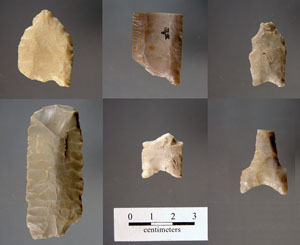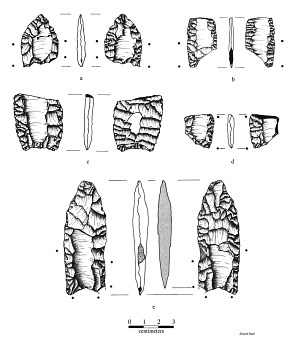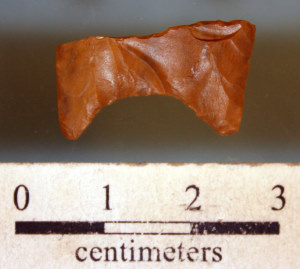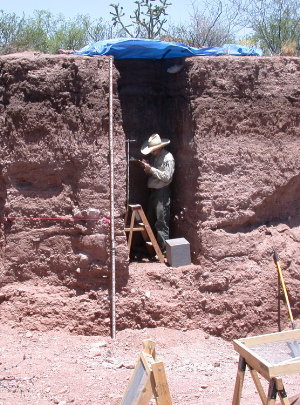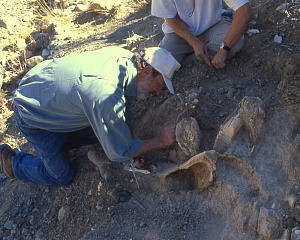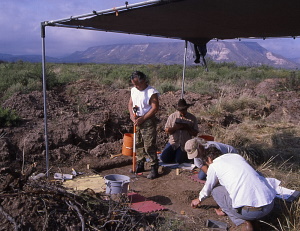Earliest Peoples
This section focuses on the eastern two-thirds of the Trans-Pecos region and draws most heavily on research across the Big Bend area. The Paleoindian record of the far western Trans-Pecos in Hudspeth County and adjacent areas of southern New Mexico is summarized in a 2004 article by Miller and Kenmotsu.
The Paleoindian prehistory of the Trans-Pecos Mountains and Basins remains little known in comparison to the Llano Estacado, the Edwards Plateau, and the Lower Pecos Canyonlands. This is largely due to the fact that very few Paleoindian sites have been documented within the region. Instead, the archeological record of these earliest Texans is dominated by numerous isolated finds of their diagnostic projectile points, including Clovis and Folsom as well as later styles such as Plainview and Golondrina. (The names of these distinctive styles of parallel-sided lanceolate spear points are often used as convenient labels for the cultures that made and used them.)
Despite the overwhelming pattern of scattered isolated projectiles, there is one very large early Paleoindian site found within the Trans-Pecos: the Chispa Creek site. This site in southern Culberson County appears to be quite different from the rest of the Paleoindian record from the region. Research now underway (2008) in the eastern Trans-Pecos is specifically designed to find other Paleoindian sites of Chispa’s importance.
The dearth of intact Paleoindian sites in the Trans-Pecos has severely limited our abilities to directly date early human history in the region. In fact, we only have one radiocarbon-dated Paleoindian occupation from the entirety of the Big Bend (see below)! We can however, reasonably assume that the early chronology established in adjacent regions generally holds for the eastern Trans-Pecos as well. The nearby areas with well-dated sites include the southern High Plains (Texas and New Mexico), the central Rio Grande Valley (New Mexico) and the Plateaus and Canyonlands of central and southwestern Texas.
Based on adjacent regions, the Paleoindian manifestations in the Trans-Pecos should date approximately to the following spans of time. (See Time for an explanation of differing time scales.)
Clovis, the first Early Paleoindian culture now widely recognized in North America, minimally dates from 11,050 to 10,800 rcybp (radiocarbon years before present), or about 11,000 to 10,850 B.C., some 13,000 to 12,850 years ago. The Clovis time span may well be considerably longer than 250 years.
Folsom, the most common Early Paleoindian culture in the Big Bend region, dates from 10,800 to 10,200 rcybp or about 10, 900 to 9,900 B.C., some 12,900 to 11,900 years ago.
Late Paleoindian period, during which such divergent projectile point styles such as Plainview, Firstview, Golondrina and Angostura were manufactured, is generally considered to date from 10,000 to 8,000 rcybp, or roughly 9600 to 7000 B.C. during the first 2,000 years of the Holocene geological period, some 11,600 to 9000 years ago. The Paleoindian era terminates around 9,000 years ago, give or take a few hundred years.
The Paleoindian record of the Trans-Pecos region mirrors a continent-wide pattern: the marked rise in the number of sites on the landscape through time. While the region has relatively few substantive Paleoindian sites, this overarching pattern is seen in the relative numbers of isolated tools found. That is to say, our current data show, for example, there are fewer Clovis points here than there are Plainview points. In fact only seven Clovis specimens are known from the entire area, but a recently discovered surface scatter in central Brewster County has produced eleven Late Paleoindian points alone. Researchers generally attribute this increase in site/isolate density to an increase in population at the beginning of the Holocene. While this population growth is almost certainly a fact, this pattern could also be attributable to groups having lived in the country for millennia by the Late Paleoindian period, such that the most advantageous locations are being repeatedly occupied or being occupied longer than seen previously during the Pleistocene. Given that we find no overt differences in where Paleoindian isolates are being found in the Trans-Pecos, it is easier to chalk up the greater number of tools from the latter portion of the period to population growth.
That said, there are far more Folsom artifacts found in the Big Bend than from any other Paleoindian technological complex. This is entirely because of one site: Chispa Creek. The site is somewhat famous because most Paleoindian archeologists have heard at least a little about this locale, but details about the site or its archeology were never widely or completely published. Because information beyond the fact that Chispa produced a very large number of Folsom tools was not forthcoming, the site took on a certain air of mystery. A little more is known about the locality now.
Chispa Creek: What it is and what it isn’t
Chispa Creek was discovered by Joe Ben Wheat, a native of Van Horn who went on to have a much lauded archeological career. In addition to his investigations at Chispa, Dr. Wheat excavated two other well known major Paleoindian sites, Olsen-Chubbuck and Jurgens (both found in Colorado), and conducted research across the prehistoric Southwest. In particular, Wheat’s reporting of the Olsen-Chubbuck bison kill is considered a classic work of Paleoindian scholarship. As testament to his prominence in the field, Wheat served as President of the Society of American Archaeology from 1966 to 1967. Not bad for a scion of the small and dusty town of Van Horn!
To say that Chispa Creek is a “Folsom site,” or even a single “site,” is a misnomer. The name Chispa Creek refers to a series of 31 sites discovered by Wheat during an informal survey of the Lobo Valley spanning the 1940s and 1950s. The Lobo Valley is a broad valley between the Van Horn Mountains on the west and the Wylie Mountains (and westernmost foothills of the Davis Mountains) on the east. The town of Van Horn sits right at the northern end of the Lobo Valley, and to the south, the valley imperceptibly grades into the highlands surrounding Marfa, TX.
All of the sites surveyed by Wheat were found within the Lobo Valley 10-20 miles south of Van Horn. Collectively, these sites contain diagnostic artifacts from all periods of prehistory and even include some historic remains. But because “the site” was found during the adolescence of Paleoindian studies and because early Paleoindian sites are so rare, the Folsom finds from the Lobo Valley have been given prominence and are usually the only materials associated with the name Chispa Creek.
The first Folsom point from the Chispa Creek sites was discovered in 1946. But, given the abundance of later archeological materials found nearby, this first Folsom was thought to be nothing more than an isolated occurrence, perhaps brought to the locale by later occupants. Ten years later, Wheat recovered some 50 Folsom projectiles and 150 scrapers thought to be of Paleoindian age from an area north of the original Folsom find—this locality is now known to be the main locus of Paleoindian activity in the area, and is the one popularly known as Chispa Creek today. All told, however, three other localities in the general vicinity yielded Folsom and other Paleoindian-aged tools. Wheat initiated excavation at the main Folsom locality in 1962 and performed another season of work at the site in 1965.
At the end of Wheat’s investigations at the Lobo Valley Paleoindian localities, a total of 90 Folsom projectiles and preforms, 47 channel flakes (flakes removed during the fluting process) and 328 scrapers thought to be of Folsom age had been documented. A smattering of other Paleoindian diagnostics, including a solitary Clovis point, was also recovered. From the perspective of the number of tools found, this locality (among the other Chispa Creek sites) was clearly a favored location for Folsom groups moving through the eastern Trans-Pecos. Upon the conclusion of his work at the site, Wheat considered the Chispa Creek Folsom site to have at least some archeological integrity, that is, that the Folsom artifacts were lying almost exactly where they were dropped over 10,000 years ago.
Southern Methodist University, with the support of the QUEST Archaeological Research Fund, carried out new investigations at the main Folsom locality at Chispa Creek in 2002. Thirteen additional Folsom tools were recovered in the process. What’s more, these were found within small areas of the site that Wheat noted as being particularly heavy in Folsom specimens. This suggests Chispa Creek does have at least some horizontal integrity; however, the vertical deposits appear to be less intact than Wheat originally believed. Wheat thought the Folsom artifacts found within a subsurface calcified stratum were in primary context; yet, a human burial he found to the south of the main Folsom locality and within the same stratum was later radiocarbon dated to the Late Holocene instead of the hoped-for Folsom age. The SMU investigation did recover a small number of artifacts subsurface at the main locality, but none were readily attributable to any specific prehistoric period. The lack of stratified contexts notwithstanding, it is very clear this particular area of the Lobo Valley was being targeted for repeated occupation by Paleoindian groups when in the eastern Trans-Pecos.
What lies behind the patterns we see in the Paleoindian-era Trans-Pecos region?
The reasons behind the favoritism shown the Lobo Valley for Paleoindian settlement most likely revolve around the accessibility in the area of numerous high-quality stone sources with which to make tools. Also, the local availability of water could have played a major role. Water was probably available in Chispa Creek itself (now called Lone Wolf Creek, a rarely flowing stream) and almost certainly to the north at the Van Horn "Wells," a still-flowing perennial spring. Lastly, the then-wetter grassland environs of Lobo Valley may have attracted bison herds—though we have no direct evidence of this. No Folsom-age animal bones were preserved at Chispa Creek.
The Folsom lithic assemblage at Chispa is dominated by local raw materials, all of which can be found at short distances from the site(s). The tools are made primarily from three different sources: Van Horn Red Felsite, Van Horn Butterscotch Jasper and Purple-Tan Chert. Eighty-two of the Folsom projectiles and preforms are manufactured of these local materials. The remaining specimens are made of Edwards chert from central Texas or are of unknown material types. Given that the geology of the Big Bend includes quite a wealth of stone suitable for flintknapping, it is entirely possible these as-yet unknown types are from undocumented quarries in the area.
The Folsom reliance on local lithic sources at Chispa Creek challenges the longstanding notion that Paleoindian groups traveled long distances to procure stone before traveling equally long distances before using and discarding the tools made. Chispa Creek instead paints a different picture. Folsom groups manufactured weaponry while within Lobo Valley, used or otherwise broke the tools while still in Lobo Valley, and ultimately discarded these same tools while essentially staying in the same place. This pattern could suggest that Folsom groups stayed in the area for extended periods of time (perhaps weeks or months). Alternatively, it is possible that tools made from Culberson County quarries were transported outside of Lobo Valley before being brought back and replaced with new tools made of the same stone during a subsequent visit. In either case, the heavy use of local materials implies a long-term familiarity with the immediate area.
Tellingly, this pattern of using local stone sources to manufacture projectile points is also reflected in the isolated finds of Paleoindian artifacts not just at Chispa Creek, but across the Big Bend. A great many of the documented finds are also made of stone local to the area. Some of these sources are quite isolated within the region’s many canyons, drainages and mountainsides. What’s more—even though the majority of the isolated finds are Late Paleoindian specimens (Golondrina, Angostura and the like), the few isolated Folsom finds from the larger Big Bend area are also made of local materials. For instance, a recently discovered Folsom base fragment from Presidio County was found approximately 1 km from the chert quarry from which the stone was procured. Two Folsom fragments recovered just south of the town of Fort Davis (Jeff Davis County) were made of a chalcedony only found in a few small veins on the southern slopes of the Davis Mountains.
Knowledge of local stone sources, some from secluded outcrops, suggests intimacy with the environs of the Big Bend. It is undoubtedly the case that even Early Paleoindian groups coming into the Trans-Pecos had accumulated a wealth of knowledge about what resources were to be found in the region. This is certainly the case with sources of tool-making stone, but undoubtedly the Paleoindian peoples knew where other resources such as concentrations of animals and plants were to be found. In turn, this suggests Paleoindian visits to the Trans-Pecos were probably frequent, wide-ranging and/or possibly of long duration.
In other words, the pattern reflected by Paleoindian raw material use in the Big Bend is one of occupation, not exploration. This raises the central paradox of Paleoindian archeology in the Trans-Pecos. We know Paleoindians were here, we know they knew what they were doing while here, but as of this writing we still have not found an intact site even remotely comparable to Chispa Creek, or any other well-known Paleoindian site for that matter. If they knew this region so well, then where are all of their sites?
There is probably no single answer to this question, but we do have some possibilities.
To begin with, it is likely that some sites dating to the Late Pleistocene and Early Holocene are deeply buried within the region’s plentiful desert basins. Site deposits dating to the Early Archaic period are often found 6–8 m below ground surface throughout Brewster County. These are often spotted in the lower layers exposed in deep arroyos. This raises the distinct possibility that Paleoindian sites could be buried below these strata in the same areas, yet remain invisible below the floors of the arroyos. A few Late Paleoindian sites have also been found buried in the higher elevations of the region’s mountains. For instance, a hearth dating to roughly 9,000 years old was uncovered over a meter below the level of the parking lot between the visitor’s center and the lodge in the Chisos Basin of Big Bend National Park. Perhaps we aren’t finding intact Paleoindian sites because we simply can’t see them.
On the other hand, geoarcheological research on selected landforms in Brewster County has revealed that Paleoindian-aged sedimentary strata have been simply eroded away across certain areas of the Big Bend. Therefore, any artifacts held by these sediments would also have been removed by erosion and deposited elsewhere or deflated onto an exposed surface. By the same token, many of the isolated surface finds from the Big Bend may be out-of-context; that is, found only after they have been displaced by erosional forces. Looking for the upslope areas these may have eroded from could be fruitful.
Perhaps we simply don’t know where to look. Archeologists modeling Paleoindian lifeways in the western United States have tended to use data from the many sites found on the Great Plains to frame their expectations. The base topography and ecology of the Trans-Pecos, however, is very different from that of the Plains, and was probably just as different during the last Ice Age as well. Therefore, using Plains-based settlement patterns and economy as the model for what we should expect to find in the Trans-Pecos may be a mistake. The ecological differences between the two regions may have necessitated a completely (or even slightly) different cultural adaptation.
This may be seen in the lack of finds of what are commonly considered Paleoindian prey species. Various mammoths have been found across the Big Bend over the years; however, those that have been analyzed tend to be disarticulated by erosion and are probably in secondary context. The ages of these mammoths are also unknown and they very well could predate the human occupation of the Americas. To date, there have been no discoveries of the Ice Age bison, Bison antiquus, and other megafauna species (such as Camelops and Northrotheriops) are very rare or non-existent. The lack of Late Pleistocene/Early Holocene paleontological finds in the region may suggest that ecology of the Big Bend was unlike other areas of Texas or the Southwest during the Paleoindian era. Thus, Paleoindians would not have been using the Trans-Pecos landscape in the same ways documented elsewhere.
With this in mind, it is possible Paleoindian groups did not exploit the Trans-Pecos in large enough numbers to leave a readily identifiable archeological signature. Perhaps the area drew relatively few Paleoindian groups because the large herbivores such as mammoths and bison were not commonly present. We do know, however, that Paleoindian peoples repeatedly visited several local quarries, but we don’t know what they did after their quarry visits. If very small group sizes were the norm during occupation of the Trans-Pecos, it is unlikely that neither relatively large nor relatively intact sites will be found, as few such sites were left behind in the first place.
If indeed the apparent dearth of megafaunal prey species in the Big Bend reflects past conditions, then we would expect that the projectile points used to hunt such animals were rarely needed, thus rarely discarded and rarely found today. Another related point is that it is possible that some marginal Paleoindian deposits, such as lithic scatters have been found that we do not recognize as such because they lack projectile points, the main finds used to identify Paleoindian sites.
The Paleoindian occupation of the Big Bend presents us with, therefore, a curious pattern. As represented by Folsom, Early Paleoindian groups well knew the locations of small stone quarries, and as seen at Chispa Creek, placed their campsites near reliable water sources. Given that reliable water sources are the same spots favored by woody plants and trees, as well as a variety of game, it is very likely these resources were also being exploited while in the area. Furthermore, quite a few of the isolated projectile points have also been found near springs or now intermittent watercourses. It appears that while in the Trans-Pecos, Paleoindian groups were keying into three reliable, stable, and ultimately vital resources: water, wood, and stone. They were probably not here following bison or mammoth herds as they have so often been popularly portrayed; though, if these animals occupied the region with any regularity, they probably would have been pursued as human prey.
Increasingly archeologists across North America are recognizing Paleoindian sites that do not conform to the “wide-ranging big game hunter” paradigm, or expected model of how the earliest peoples lived. Several sites in Texas, for example, are causing us to realize that Paleoindian lifestyles were much more varied than the prevailing notions allow for. For example, recent excavations at the Gault site near Ft. Hood show that even Clovis-age Paleoindians were returning over and over again to highly favorable spots on the landscape. Gault is located at the head of a perennial stream in a wooded valley—and, this stream is cutting through limestone formations containing plentiful chert. Due to its location, small game and plant foods would have been locally abundant. While mammoth, horse and bison remains were also found at the site, the overall impression is one of a more generalized hunting and gathering lifestyle. Similar sites, such as Aubrey (also in Texas), Indian Creek (Montana) and Daisy Cave (California) also show that Early Paleoindians were no strangers to broad spectrum, so-called “Archaic” diets. Given the availability of a wide range of resources and contrasting adjacent ecological zones (ecotones) in the Big Bend area, we might expect a similar “non-Paleo” archeological signature here as well.
In 2006 the Center for Big Bend Studies at Sul Ross State University began a research program to find Paleoindian sites in the Big Bend. While as of yet no promising sites have been found, this is not for lack of trying. We have completed many acres of survey in areas we think may hold sites of this age and have additionally used backhoe trenches and test pits to view the subsurface deposits at sites producing Paleoindian tools on their surfaces. Unfortunately, intact subsurface deposits have yet to be found.
Optimistically, however, what little evidence we do have from the Paleoindian era in the region indicates the Big Bend was quite well known to the earliest indigenous peoples. We hope and expect that it is only a matter of time before their sites are found. Because Trans-Pecos Paleoindians appear to have been behaving appreciably differently that the standard Plains big game hunting mode, a well-preserved site from this time period could answer many questions. Not only those specific to the prehistory of Trans-Pecos Texas, but also those that bear on what we think we know about Late Pleistocene/Early Holocene cultural adaptations continent-wide.
Contributed by John D. Seebach.
Sources
Amick, Daniel S. and Jack L. Hofman
1999 Joe Ben Wheat’s Investigations at Chispa Creek in Trans-Pecos, Texas. Current Research in the Pleistocene 16:3-5.
Bever, Michael R. and David J. Meltzer
2007 Exploring Variation in Paleoindian Life Ways: The Third Revised Edition of the Texas Clovis Fluted Point Survey. Bulletin of the Texas Archeological Society 78:65-99
Bousmann, C. Britt, Barry W. Baker and Anne C. Kerr
2004 Paleoindian Archeology in Texas. In The Prehistory of Texas, edited by
Timothy K. Perttula, pp. 15-97. Texas A&M University Press, College Station.
Enlow, Donald H. and Thomas N. Campbell
1955 Some Paleo-Indian Projectile Points from the Southeastern Periphery of the Great Plains. Panhandle Plains Historical Review 28:29-38.
Mallouf, Robert J. and John D. Seebach
2006 Filling in the Blanks: Early Paleoamericans in the Texas Big Bend. Current Research in the Pleistocene 23:140-142.28:29-38.
Miller, Myles R. and Nancy K. Kenmotsu
2004 Prehistory of the Jornada Mogollon and Eastern Trans-Pecos Regions of West Texas. In The Prehistory of Texas, edited by Timothy K. Perttula, Texas A&M University Press.
Seebach, John D.
2004 Past and Present at the Chispa Creek Folsom Site. Journal of Big Bend Studies 16:1-30.
Simmons, Alan H. (with Douglas D. Dykeman and Patricia A. Hicks)
1989 Early Man in the Southwest—The Paleo-Indians. In Human Adaptations and Cultural Change in the Greater Southwest by Alan H. Simmons, Ann Lucy Wiener-Stodder, Douglas D. Dykeman and Patricia A. Hicks, pp. 21-38. Arkansas Archeological Survey Research Series 32, Arkansas Archeological Survey, Fayetteville.
Waters, Michael R. and Thomas W. Stafford
2007 Redefining the Age of Clovis: Implications for the Peopling of the Americas. Science 315:1122-1126.
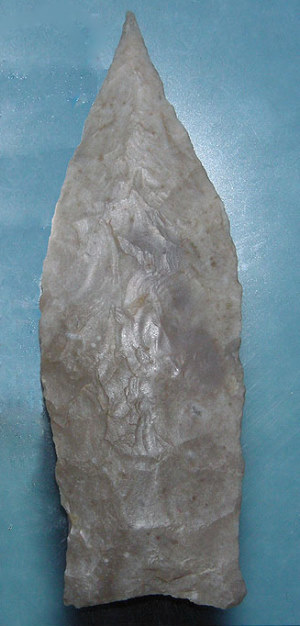
|
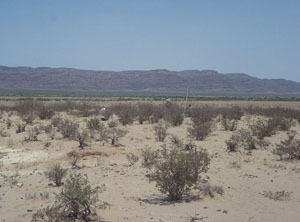
|
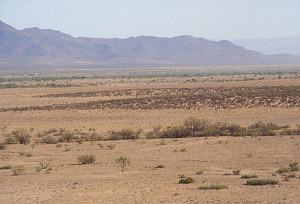
|
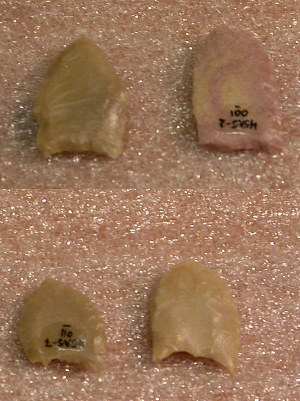
|
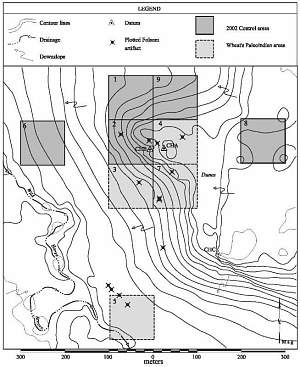
|
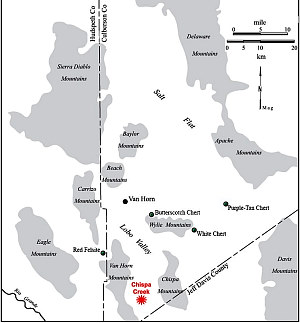
|
